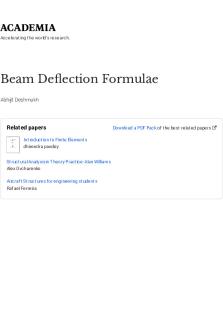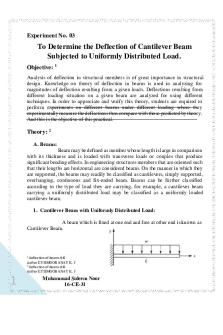To Determine the Deflection of Cantilever Beam Subjected to Uniformly Distributed Load PDF

| Title | To Determine the Deflection of Cantilever Beam Subjected to Uniformly Distributed Load |
|---|---|
| Course | Theory of Structure-1 |
| Institution | University of Engineering and Technology Taxila |
| Pages | 7 |
| File Size | 646.9 KB |
| File Type | |
| Total Downloads | 41 |
| Total Views | 140 |
Summary
Lab report of Practical on Cantilever Beam to find out deflection under UDL...
Description
Experiment No. 03
To Determine the Deflection of Cantilever Beam Subjected to Uniformly Distributed Load. Objective: 1 Analysis of deflection in structural members is of great importance in structural design. Knowledge on theory of deflection in beams is used in analyzing for magnitudes of deflection resulting from a given loads. Deflections resulting from different loading situation on a given beam are analyzed for using different techniques. In order to appreciate and verify this theory, students are required to perform experiments on different beams under different loading where they experimentally measure the deflections then compare with those predicted by theory. And this is the objective of this practical.
Theory: 2 A. Beams: Beam may be defined as member whose length is large in comparison with its thickness and is loaded with transverse loads or couples that produce significant bending effects. In engineering structures members that are oriented such that their lengths are horizontal are considered beams. On the manner in which they are supported, the beams may readily be classified as cantilevers, simply supported, overhanging, continuous and fix-ended beam. Beams can be further classified according to the type of load they are carrying, for example, a cantilever beam carrying a uniformly distributed load may be classified as a uniformly loaded cantilever beam. 1. Cantilever Beam with Uniformly Distributed Load: A beam which is fixed at one end and free at other end is known as Cantilever Beam.
1
Deflection of Beams RIG Author EYSIMGOBANAY K. J 2 Deflection of Beams RIG Author EYSIMGOBANAY K. J
1
Muhammad Saleem Noor 16-CE-31
B. Deflection: 3 The word deflection generally refers to the deformed shape and position of a member subjected to bending loads. In deformed condition the neutral axis which is initially a straight longitudinal line assumes some particular shape which is called deflection curve. The deviation of this curve from its initial position at any point is called deflection at that point. In developing the theory determining deflection of a beam, it is assumed that shear strain do not significantly influence the deformation. The deflection equation is given as: 𝑳 𝑴𝒎
∆ = ∫𝟎
𝑬𝑰
Where, M = Moment due to real load Mv = m = Moment due to vertical load E = Modulus of Elasticity I = Moment of Inertia There are various methods of determining beam deflections common amongst these are: i) Deflection by (Double) direct integration ii) Deflection by moment-area method iii) Strain- Energy or Catigliano’s method iv) Method of superposition C. Formulas: 1. Deflection at Free End:
∆max = -wL4 / 8EI
3
Deflection of Beams RIG Author EYSIMGOBANAY K. J
2
Muhammad Saleem Noor 16-CE-31
2. Deflection at Any Point:
∆=
−𝑾 𝟐𝟒𝑬𝑰
(x4 - 4Lx3 + 6L2x2)
Apparatus: 1. 2. 3. 4.
Beam Apparatus Uniformly Distributed Load Meter Rod / Scale Dial Gauge
Uniformly Distributed Load
Meter Rod
3
Muhammad Saleem Noor 16-CE-31
Beam Apparatus
Dial Gauge
Procedure: Set the apparatus to make it cantilever beam. First of all find the full length of beam by using meter rod and record it as L. Mark the points where you find the deflection in beam and note their values as x1, x2 and so on. Note the weight of each UDL and then find intensity and note it as w. Apply different loads at all the points one by one and record them as w1, w2, w3 and so on. Attach the dial gauge with beam at the point where you want to find deflection. Press on key and note the value on dial gauge. Record these values as experimental deflection. Now find the theoretical values by using formulas given below: ∆max = -wL4 / 8EI −𝑾
∆ = 𝟐𝟒𝑬𝑰 (x4 - 4Lx3 + 6L2x2)
4
Muhammad Saleem Noor 16-CE-31
Now compare both the values and find error.
Adjusting Dial Gauge at Free End
Measuring Length of Beam (L)
Adjusting Dial Gauge at Free End
5
Muhammad Saleem Noor 16-CE-31
Measuring Deflection at Free
Measuring Deflection at Free End
Calculations: A. Data: Sr.
Description
Values
1
Full length of beam = L =
50 cm = 0.5 m
2
Position of 1st point = x1 =
25 cm = 0.25 m
3
Position of 2nd point = x2 =
50 cm = 0.5 m
4
Weight of 1st UDL = w1 =
24.72 N/m
5
Weight of 1st UDL = w2 =
49.44 N/m
6
Weight of 1st UDL = w3 =
74.16 N/m
7
Weight of 1st UDL = w4 =
98.88 N/m
8
Weight of 1st UDL = w5 =
123.6 N/m
9
Moment of inertia = I =
4.5 × 10-10 m4
10
Modulus of elasticity = E =
200 × 109 Nm-2
No.
B. Deflection at Point x1: Put all the loads one by one in the equation given below, ∆=
6
−𝑾 𝟐𝟒𝑬𝑰
(x4 - 4Lx3 + 6L2x2)
Sr. No.
Load (W)
1
% error
Deflection (∆) Experimental
Deflection (∆) Theoretical
24.72 N/m
0.79 mm
0.76 mm
3.79
2
49.44 N/m
1.61 mm
1.52 mm
5.59
3
74.16 N/m
2.41 mm
2.28 mm
5.39
4
98.88 N/m
3.25 mm
3.03 mm
6.77
5
123.6 N/m
4.08 mm
3.79 mm
7.11
Muhammad Saleem Noor 16-CE-31
(
𝑬𝒙𝒑 – 𝑻𝒉 𝑬𝒙𝒑
) × 100
C. Deflection at Free End: Put all the loads one by one in the equation given below, ∆max = -wL4 / 8EI Sr.
Load (W)
No.
Deflection (∆)
Deflection (∆)
Experimental
Theoretical
% error (
𝑬𝒙𝒑 – 𝑻𝒉 𝑬𝒙𝒑
) × 100
1
24.72 N/m
1.76 mm
2.14 mm
21.59
2
49.44 N/m
3.78 mm
4.29 mm
13.49
3
74.16 N/m
5.74 mm
6.43 mm
12.02
4
98.88 N/m
7.78 mm
8.58 mm
10.28
5
123.6 N/m
9.93 mm
10.73 mm
8.06
Precautions: While taking the experiment we have to take care of measurements and the locations where we have to take the readings. The beam should be stable. It should be statistically determinant.
Remarks: Deflection is going to increase as we move from fixed end to free end.
7
Muhammad Saleem Noor 16-CE-31...
Similar Free PDFs

Deflection of a Cantilever Beam
- 8 Pages

Vibrations of a Cantilever Beam
- 13 Pages

Deflection of beam - assignment
- 23 Pages

Beam Deflection Formulae
- 3 Pages

Tutorial 09 Beam Deflection
- 1 Pages
Popular Institutions
- Tinajero National High School - Annex
- Politeknik Caltex Riau
- Yokohama City University
- SGT University
- University of Al-Qadisiyah
- Divine Word College of Vigan
- Techniek College Rotterdam
- Universidade de Santiago
- Universiti Teknologi MARA Cawangan Johor Kampus Pasir Gudang
- Poltekkes Kemenkes Yogyakarta
- Baguio City National High School
- Colegio san marcos
- preparatoria uno
- Centro de Bachillerato Tecnológico Industrial y de Servicios No. 107
- Dalian Maritime University
- Quang Trung Secondary School
- Colegio Tecnológico en Informática
- Corporación Regional de Educación Superior
- Grupo CEDVA
- Dar Al Uloom University
- Centro de Estudios Preuniversitarios de la Universidad Nacional de Ingeniería
- 上智大学
- Aakash International School, Nuna Majara
- San Felipe Neri Catholic School
- Kang Chiao International School - New Taipei City
- Misamis Occidental National High School
- Institución Educativa Escuela Normal Juan Ladrilleros
- Kolehiyo ng Pantukan
- Batanes State College
- Instituto Continental
- Sekolah Menengah Kejuruan Kesehatan Kaltara (Tarakan)
- Colegio de La Inmaculada Concepcion - Cebu










